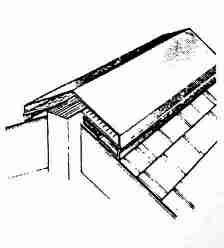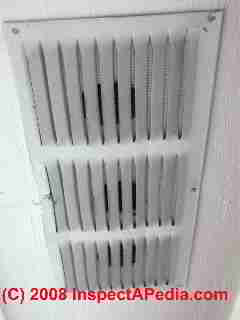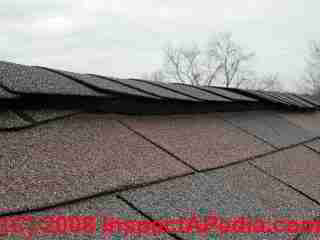 Why Both Ridge & Soffit Venting are Needed under Building Roofs
Why Both Ridge & Soffit Venting are Needed under Building Roofs
- POST a QUESTION or COMMENT about attic moisture, condensation & ventilation: why are both soffit intake and ridge outlet needed?
Here we explain why a functional roof venting system needs both intake venting at the eaves or soffits and outlet venting at the roof peak or ridge.
This article series explains How to Correct Inadequate Attic Venting to Stop Attic Condensation, Ice Dam Leaks, Attic Mold, & Roof Structure Damage.
Our photo at page top shows a modern synthetic mesh type ridge vent (with modest airflow capacity) and our photo at left shows a typical installation of continuous soffit or eaves intake venting at the lower roof edges of a building.
InspectAPedia tolerates no conflicts of interest. We have no relationship with advertisers, products, or services discussed at this website.
- Daniel Friedman, Publisher/Editor/Author - See WHO ARE WE?
Both Ridge and Eaves Venting Are Necessary
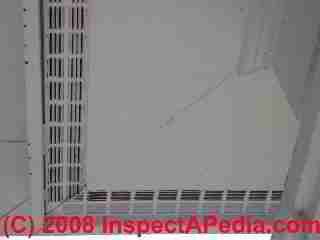
Both Ridge and Eaves or Soffit Ventilation are Needed in buildings. This article describes inspection methods and clues to detect roof venting deficiencies, insulation defects, and attic condensation problems in buildings. It describes proper roof ventilation placement, amounts, and other details.
This article is part of the series ROOF VENTILATION SPECIFICATIONS and also ATTIC CONDENSATION CAUSE & CURE.
Beware of adding a ridge vent without soffit vents (the worst) or soffit vents without a ridge vent (bad) or only gable-end vents (usually bad).
The up-draft of air from the building (convection current of rising warm air which moves up through most buildings) will be increased and will mean unnecessary heat loss if you have a ridge vent to vent air out without also providing good intake venting at the soffits or eaves.
Installing only a ridge vent and no or inadequate soffit venting is likely to result in unnecessary heat loss from the building as convection currents of rising warm air in the attic, unable to easily draw in air from outside, will "suck" warm air from the building, thus increasing unnecessary heat loss and increasing the risk of ice damming.
Providing a lot of easy air intake at the building eaves avoids this problem.
Installing only soffit venting and no ridge vent works better than a ridge-only vent and this design was used on many residential buildings.
But it's not nearly as effective as a ridge and soffit vent combination, first because air moves through the attic space only when wind is blowing in the right direction, towards one of the walls of the Building which has a vented roof overhang, and second, because there is no high exit point to permit warmer air to exit by natural convection.
To be scrupulously fair, on a few buildings with very large gable end vents, lots of insulation in the attic floor, and perhaps lucky house siting, I have seen attics that were perfectly dry and free of condensation, ice dams, and mold. But these have been the exception, not the rule, at least for inspections in northern climates subject to cold winters and hot humid summers.
A High-Capacity Ridge Vent Moves More Air than a Low-Profile Good-looking Vent

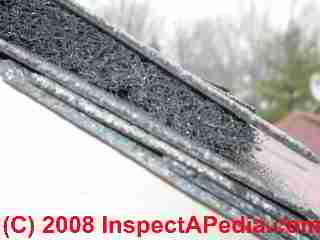
The popular plastic mesh type ridge vent shown in this photograph is popular where ridge vents are installed on new homes or as retrofits. Builders and owners like the ability to nail roof shingles over the easily-stored, transported, and installed roll-out plastic mesh that is simply laid across an opening cut along the building's ridge.
But we have observed that this ridge vent design passes much less air than the older, uglier aluminum ridge vent shown in our sketch above. We prefer the older product which moves air.
Continuous High Capacity Eaves or Soffit Intake Venting Provides Adequate Intake Air Under Roofs
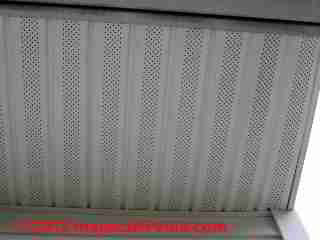

As we show in this pair of photos, continuous soffit intake venting will provide optimum intake air flow between every rafter pair.
Installing Continuous High Capacity Eaves or Soffit Intake Venting Works Best to Avoid Attic Moisture, Mold, & Ice Dams
Here are examples of inadequate intake ventilation: vents at the soffits are intermittent or "spot vents" or are simply too small.
Don't install intermittent or occasional or faux soffit intake venting or vents with too little opening area such as we show in the photo at left.
Not only are the openings too small to pass enough air (obstructed further by the louvers and insect screens), intermittent soffit intake vents or little round or rectangular soffit spot vents are singularly ineffective in providing good under-roof or attic ventilation.
 Continuous soffit/eaves intake venting is the proper location for the intake air, in order to assure that the entire under-side of the roof sheathing is vented and kept dry. Not what is shown in our photo (left).
Continuous soffit/eaves intake venting is the proper location for the intake air, in order to assure that the entire under-side of the roof sheathing is vented and kept dry. Not what is shown in our photo (left).
Where we inspect attics with "spot vents" in the soffits (those little round louvered vents ranging from about 3/4" diameter (photo at left) to 2" in diameter or even 4" in diameter are completely ineffective, never moving enough air.
In these attics of buildings in climates where moisture is often a concern, we find moisture stains in the attic at the building eaves, sometimes moldy building insulation, and on occasion serious attic moisture and condensation problems.
Where we inspect attics where even larger vent openings are provided in the soffits or eaves, if the openings are intermittent, we see wet and often moldy roof sheathing on those roof sections where no venting is provided (the "in-between-vent" roof sections), even though at other roof sections where vents are present the sheathing often looks clean and dry.
This is compelling visual evidence that air is not moving up the under-side of the sections of roofing where no intake vents are present at the building eaves. Venting needs to be provided between every rafter pair at the eaves and ridge.
Just as we want continuous intake venting along the building eaves, continuous ridge venting is the optimum exit path for warm rising air in an attic, thus pulling new cooler, drier outside air into the under-roof area from between every rafter pair.
(C)Daniel Friedman - copyright protection trap.
...
Continue reading at ROOF VENTILATION SPECIFICATIONS or select a topic from the closely-related articles below, or see the complete ARTICLE INDEX.
Or see ROOF VENTILATION FAQs for questions & answers on venting hard-to-vent roofs in buildings of various age, design, and situation.
Or see these
Recommended Articles
Suggested citation for this web page
ROOF VENT SOFFIT + RIDGE NEEDED at InspectApedia.com - online encyclopedia of building & environmental inspection, testing, diagnosis, repair, & problem prevention advice.
Or see this
INDEX to RELATED ARTICLES: ARTICLE INDEX to BUILDING VENTILATION
Or use the SEARCH BOX found below to Ask a Question or Search InspectApedia
Ask a Question or Search InspectApedia
Questions & answers or comments about attic moisture, condensation & ventilation: why are both soffit intake and ridge outlet needed?
Try the search box just below, or if you prefer, post a question or comment in the Comments box below and we will respond promptly.
Search the InspectApedia website
Note: appearance of your Comment below may be delayed: if your comment contains an image, photograph, web link, or text that looks to the software as if it might be a web link, your posting will appear after it has been approved by a moderator. Apologies for the delay.
Only one image can be added per comment but you can post as many comments, and therefore images, as you like.
You will not receive a notification when a response to your question has been posted.
Please bookmark this page to make it easy for you to check back for our response.
IF above you see "Comment Form is loading comments..." then COMMENT BOX - countable.ca / bawkbox.com IS NOT WORKING.
In any case you are welcome to send an email directly to us at InspectApedia.com at editor@inspectApedia.com
We'll reply to you directly. Please help us help you by noting, in your email, the URL of the InspectApedia page where you wanted to comment.
Citations & References
In addition to any citations in the article above, a full list is available on request.
- Mark Cramer Inspection Services Mark Cramer, Tampa Florida, Mr. Cramer is a past president of ASHI, the American Society of Home Inspectors and is a Florida home inspector and home inspection educator. (727) 595-4211 mark@BestTampaInspector.com 11/06 and 12/08
- Daniel Friedman -edited and added to comments from John Annunziata, P.E. - NY Metro ASHI during informal chapter discussions about roof and attic ventilation options (1986-1996).
- Our recommended books about building & mechanical systems design, inspection, problem diagnosis, and repair, and about indoor environment and IAQ testing, diagnosis, and cleanup are at the InspectAPedia Bookstore. Also see our Book Reviews - InspectAPedia.
- In addition to citations & references found in this article, see the research citations given at the end of the related articles found at our suggested
CONTINUE READING or RECOMMENDED ARTICLES.
- Carson, Dunlop & Associates Ltd., 120 Carlton Street Suite 407, Toronto ON M5A 4K2. Tel: (416) 964-9415 1-800-268-7070 Email: info@carsondunlop.com. Alan Carson is a past president of ASHI, the American Society of Home Inspectors.
Thanks to Alan Carson and Bob Dunlop, for permission for InspectAPedia to use text excerpts from The HOME REFERENCE BOOK - the Encyclopedia of Homes and to use illustrations from The ILLUSTRATED HOME .
Carson Dunlop Associates provides extensive home inspection education and report writing material. In gratitude we provide links to tsome Carson Dunlop Associates products and services.


